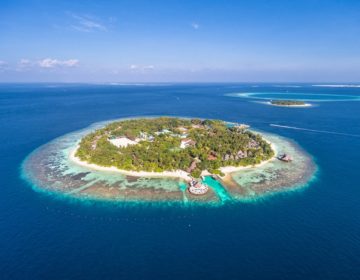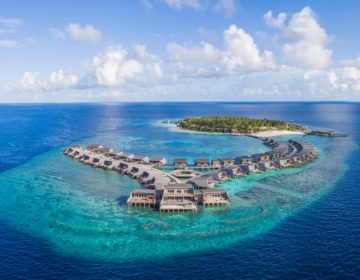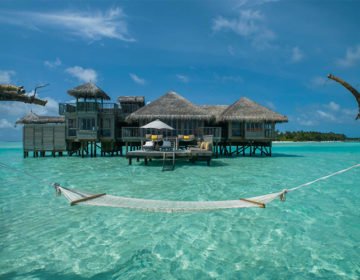The seabed east of Malé Atoll shelves steeply to 2,000 meters and the west less steeply to over 300 meters. The presence of deep, clear waters all around the atoll means excellent visibility, especially with in-going currents. Pelagics such as barracuda, trevally and tuna, and big schools of fusilier, snapper, and sharks all congregate at the entrances to the channels, attracted by the movement of water and the food sources carried with them. Depths inside the atoll are generally 40 to 50 meters, and the bottom is mostly sand. There are many shallow water reefs inside the atoll, and those just below the surface are clearly defined by sharp contrasts in watercolor. Most of the diving in North Malé Atoll is in the channels, or kandus, through the outer barrier reef of the atoll. There are around 20 channels on the eastern side and 16 on the west.
Drift diving is the most common method of diving. The channels on the western side are generally wider, some with big thilas across the openings. The highest concentration of diving is in the southern end of the atoll where many of the resorts are located. This was the first area to be dived when resorts began springing up in 1972. Some of the most beautiful sites are to be found here, and although many of them have been heavily dived, in general, the sites remain in good condition.
Most divers tend to steer away from the populated island of Malé because of heavy boat traffic. The reefs in the north of North Malé Atoll are less frequently dived than those to the south and with an absence of any islands between Helengeli and Meerunfenfushi – a distance of 20km – a sense of isolation and freedom make the dives in the northeast even more memorable.
 Gangehi Island Resort Maldives, Gaafaru Falhu
Gangehi Island Resort Maldives, Gaafaru Falhu
Gaafaru Wrecks
One of the main shipping routes through the Maldives is in the 10km wide channel between Gaafaru Falhu and the small atoll of Kaashidhoo. Some ships have drifted too far south in the channel, only to find themselves wrecked on Gaafaru Falhu. There are at least six wrecks recorded on Gaafaru Falhu. Some wrecks have been located, and the most likely identity of three of them has been established. Some wreckage lies in deep water, and more research is needed before their identity can be determined.
SS Sea Gull
The SS Sea Gull, a ship of 1012 tonnes with a crew of 32 and three passengers was wrecked in 1879, 200 meters north of the shallow entrance to Gaafaru. The anchor of the SS Sea Gull is on the reef at one meter and is visible at low tide. H.C.P. Bell, the archaeologist of the Maldives, first visited the Maldives in 1879 to investigate this wreck. Most of the ship is on the reef top at 45 degrees to the reef edge. The remains are heavily encrusted in coral, but certain parts can be distinguished. What looks like the engine and some rib sections lie just below the surface on the edge of the reef. At nine meters the reef starts to fall steeply away to more than 50 meters. There are many grouper around the wreckage and a surprising number of spider shells. There is one cave at 30 meters near the wreck, but the wreck is the main feature of this dive.
 The anchor of the SS Sea Gull is on the reef at one meter and is visible at low tide.
The anchor of the SS Sea Gull is on the reef at one meter and is visible at low tide.
Erlangen
The wreck of the 3,500-tonne German ship Erlangen lies 1.5 km west of the Iruvai Kandu. It was named after the German city of Erlangen and was traveling from Colombo to Hamburg with general cargo when it was wrecked in 1894. No lives were reported lost. Many of the remains are on the reef top above 15 meters. The remainder is over the edge to 50 meters.
Diving
The remains of the bow section, including anchors, anchor chain, anchor winch, davits and steel plates from the hull lie on the reef top and are heavily encrusted in coral. A section of ribbing protrudes from the reef between 15 and 20 meters and makes an interesting backdrop for photographs. The wreckage is about 30 meters wide. Over the years, the ship has broken in half at a depth of 30 to 35 meters, and the stern section is resting on the starboard side. The propeller is at a depth of about 45 meters and among the stern are two boilers in about 35 meters.
Fish life is interesting with many juvenile wrasses in the shallows and nudibranchs feeding on the coral algae. There are black-saddled coral grouper, as well as emperor. Oriental and harlequin sweetlips are common, and there are a couple of giant sweetlips roaming among the mid-section. Black snapper swim freely around the wreck.
 Oriental and harlequin sweetlips are common.
Oriental and harlequin sweetlips are common.
Diving Hints
This is an excellent wreck dive, but it is easy to be tempted to go to great depths. A safe plan is to dive first where the ship is broken in half and view the remains from there, then return slowly back up to the reef where a safety stop can be comfortably made while looking over the shallower parts of the wreck.
Lady Christine
The Lady Christine was engaged in survey work and laying communications cable when it ran onto the northwest of Gaafaru Falhu at 23h00 on April 16, 1974. A local tugboat tried unsuccessfully to pull the ship off the reef in rough weather and big waves. Another big tug was immediately called from Singapore to try and rescue the vessel with it with its valuable cargo of cables and communication equipment.
The ship was holed, and two days after running onto the reef the engine room and much of the inside was filled with water. One week later it was full of water, and the Singapore tugboat was still on its way. Meanwhile, local workers were paid a lot of money to save the cable and contents. When the ship’s owners arrived by chartered aircraft, they were shown the rescued cable, all neatly coiled and proudly displayed by the workers. Desperate measures were employed to save the ship but even two days of blasting the reef to make a channel were ineffectual. The vessel was stripped of anything of value and abandoned. Divers can see the holes in the reef caused by blasting.
 The Lady Christine ran onto the northwest of Gaafaru Falhu.
The Lady Christine ran onto the northwest of Gaafaru Falhu.
Diving
The Lady Christine was driven high onto the reef 300 meters west of Hulhangu Kandu, and part of the bow remains visible even at high tide. Most of the wreckage lies scattered on the upper reef slope to a depth of 10 meters. The wreck and pitted reef provide a protected environment for a wide range of marine life such as surgeonfish, yellow-back fusilier, parrotfish, moray eels, pufferfish, grouper, head-band butterfly fish, crescent-tail big-eye and Moorish idol. The variety of marine life is fantastic; it’s not uncommon to find hawksbill and green turtles, Napoleon, eagle rays, barracuda and stingrays, all in one dive.
A vertical wall drops to more than 50 meters on the outside; visibility is usually excellent. There are interesting caves at 30 meters with sea fans and sponge. One cave has a swim-through to the next, and another has part of the wreckage inside. Nurse sharks are often seen inside. This dive offers a great combination of wreck and marine life.
Diving Hints
Once the wreck has been located, it’s a good idea to dive directly down to view the caves and look into the clear waters for large pelagics, then return to the shallows among the wreckage for the remainder of the dive.
Experience these once-in-a-lifetime dives and book your hotel here.
 There are interesting caves at 30 meters with sea fans and sponges.
There are interesting caves at 30 meters with sea fans and sponges.
(Source: Dive Maldives: A Guide to the Maldives Archipelago. Tim Godfrey. Atoll Editions, 2015)



